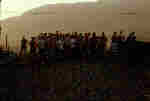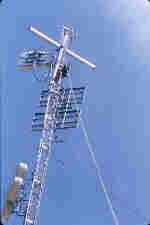Other countries do things differently. And being at war along side the Americans is an education. Not because they're better or worse. Simply because they're different.
Let me illustrate this with a story of our airforce. It's not strictly to do with Vietnam, but it is true.
It goes back to the time we bought these nice new F111's off the yanks. Now the F111's were a revolutionary design in their day. The only problem was that the wings tended to fall off when you drove the thing around a corner too fast. So for a while there the Australian government refused to take delivery of the aircraft and they sat on a runway somewhere, (Fort Bragg, from memory) all 24 of them, waiting for the problems with the follow through box to be fixed.
I might digress for a moment to talk about the problem with the follow through box because it was quite a nice little story in its own right.
The follow through box is the bit on which the swing wings hang. When the plane goes aronnd a corner the entire weight of the plane is carried by the follow through box. It has to be strong. And when the plane was designed there was no metal in the world that was strong enough to construct the box. Still it was not considered a major hurdle because by the time the aircraft was ready to fly it was believed a sufficiently strong form of steel would be available. And it was. A special crystaline steel, machined and slowly cured, and strong enough to do the job.
Except the wings fell off.
And no one could figure out why.
Eventually they solved the problem. Turns out the steel was being specially mixed, carefully machined, then heated and cured to produce exactly the right crystaline structure in the steel. Then some turkey with a set of punches was hammering the part number into the metal.
Oooops!
It makes you wonder how the Wright brothers ever got off the ground.
In the mean time the Americans didn't stop flying their F111's. They simply told their pilots to avoid sharp corners for the time being and every one was happy.
The problem arose with 24 Australian aircraft sitting on the runway of an American airbase and from the different way the two countries organise their airforces. The Australian aircraft technicians are (or were then. I've no idea what they do now) trained to fix the modules that make up the aircraft. The Americans were trained to replace them.
This latter approach was logical. The F111 was practically all modules. If a module didn't work just swap that module for one that did and you plane is back in the air in no time.
So look at it from the point of view of an Americian technician at Fort Bragg. Are you going to bother trying to fix a faulty module or wander out onto the runway and help yourself to one of 24 brand new spares sitting in the brand new Australian aircraft.
The result was when we finally took delivery of these aircraft the varous modules in all the aircraft showed thousands of flight hours on equipment that suposedly had never been in the air. Much of the equipment was full of faults and it was years before the squadron was functioning as it should.
Again it was not malicious intent on the part of the Americans. It was just the way the system worked. Talking to US technicians in Vietnam they explained the procedure to me. A squadron would load all the bum modules into a single airframe, rotate that plane back to the US and get a brand new replacement airframe equipped with brand new fully functioning modules. Heaps of time and effort was spared at the sharp end of the enterprise and the dud aircraft and modules were fixed or scrapped or whatever back at some workshop somewhere.
The assumption was that when we took delivery of the F111's we would automatically do the same sort of thing; Dud the old modules (which would be sent off for reconditioning) and fit new modules throughout.
Of course the Australian Services don't work that way. What you're given is what you get and that's it. The RAAF, in the interest of not upsetting Uncle Sam, knuckled down and set about the task of reconditioning the modules in house. In fact it's doubtful if anybody at the top end of the tree of command knew there was a problem. After all it doesn't do anybody's career any good to go around slaging our major ally. But the technicians knew. I got the story from my brother who worked on the F111's a few years later. It was still a sore point among the technicians. After all how often do you buy brand new second hand aircraft?
I suppose, in a way, it reflects on the American world view. Goods are cheap, and expendable. Why fix something when you can get another one for next to nothing. I'll never forget the image of the Americans pushing a perfectly good helicopter overboard as they evacuated the last people from the Siagon embassy at the end of the war. There was simply not enough room on the flight deck. Something had to go and a mere helicopted was expendable. It was a measure, in a sense, or American wealth.
Had we done it it would have significantly reduced (if not wiped out) our air capability. But for Uncle Sam... A helicopted?
A trifle!
Which brings me to a similar experience in our unit. A couple of the guys who should remain nameless to protect the not so innocent went to some Americian base somewhere and bought a jeep. The jeep had a broken diff and was going to be scrapped. So they organised a truck, brought the jeep back to Vung Tau, replaced the diff and had themselves a nice little buggy for hooning around Vung Tau.
The total cost? - After all the Americans were scrapping the jeep anyway - 1 carton of Victorian Bitter.





